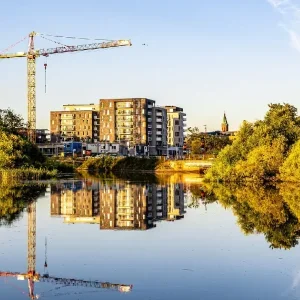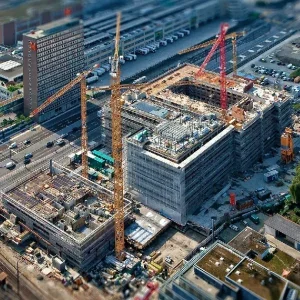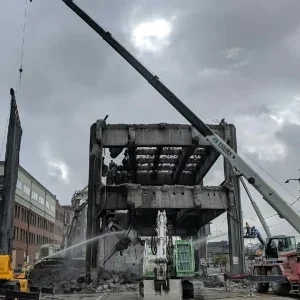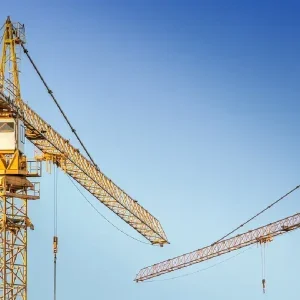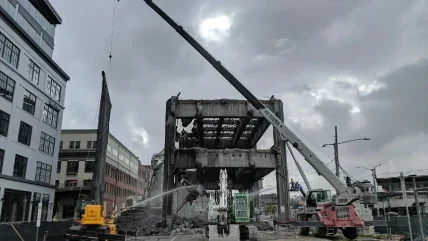
Introduction
The cranes industry, essential for construction, logistics, and infrastructure development, faces increasing challenges due to extreme weather events. These events, driven by climate change, can disrupt operations, damage equipment, and pose safety risks. This article explores the impacts of extreme weather on the cranes industry, discusses the challenges posed by these events, and outlines strategies to mitigate their effects. By understanding these factors and implementing adaptive measures, industry players can better navigate the growing risks associated with extreme weather.
The growing frequency and intensity of extreme weather
Definition and causes
Extreme weather events are severe or unusual weather conditions that can cause significant disruption. These events include hurricanes, tornadoes, floods, heatwaves, and severe storms. Several factors contribute to the increasing frequency and intensity of extreme weather:
- Climate Change: Rising global temperatures lead to more intense and frequent weather events.
- Urbanisation: Increased urbanisation can exacerbate the effects of extreme weather, such as urban heat islands and increased runoff.
- Environmental Degradation: Deforestation, soil erosion, and other forms of environmental degradation can amplify the impacts of extreme weather.
Historical context
Recent years have seen numerous extreme weather events affecting the cranes industry and related sectors:
- Hurricane Katrina (2005): This devastating hurricane caused widespread damage to infrastructure and construction projects along the Gulf Coast.
- Superstorm Sandy (2012): Sandy caused extensive flooding and wind damage in the Northeastern United States, impacting construction sites and crane operations.
- California Wildfires (2017-2020): Prolonged wildfire seasons have disrupted construction activities and posed safety risks for crane operations.
Impacts on the Cranes Industry
Operational disruptions
Extreme weather events can cause significant operational disruptions, including:
- Project Delays: Severe weather can halt construction activities, leading to project delays and increased costs.
- Equipment Damage: High winds, flooding, and other weather conditions can damage cranes and other construction equipment.
- Site Access Issues: Extreme weather can make it difficult for workers and equipment to access construction sites.
Safety risks
Safety is a primary concern in the cranes industry, and extreme weather events can exacerbate safety risks:
- Wind Hazards: High winds can cause cranes to collapse or topple, posing significant risks to workers and nearby structures.
- Flooding: Flooded construction sites can create hazardous working conditions and damage electrical systems and machinery.
- Heatwaves: Extreme heat can lead to heat stress and other health issues for workers, reducing productivity and increasing safety risks.
Financial implications
The financial impacts of extreme weather on the cranes industry can be substantial:
- Increased Costs: Repairing or replacing damaged equipment and infrastructure can lead to significant expenses.
- Insurance Premiums: Frequent extreme weather events can drive up insurance premiums for construction projects and equipment.
- Revenue Loss: Project delays and disruptions can result in lost revenue and financial penalties for missed deadlines.
Strategies for mitigating the impact of extreme weather
Enhanced equipment design and technology
Investing in advanced equipment design and technology can help mitigate the impacts of extreme weather:
- Wind-Resistant Cranes: Developing cranes that can withstand higher wind speeds and other adverse weather conditions.
- Remote Monitoring: Utilising IoT and remote monitoring systems to track weather conditions and crane performance in real time.
- Predictive Maintenance: Implementing predictive maintenance programmes to identify potential equipment issues before they result in failures.
Site preparation and risk assessment
Proper site preparation and risk assessment are crucial for minimising the impact of extreme weather:
- Site Analysis: Conducting thorough site analysis to identify potential weather-related risks and vulnerabilities.
- Drainage Systems: Implementing effective drainage systems to manage water runoff and prevent flooding.
- Weather-Resistant Structures: Constructing weather-resistant structures to protect cranes and other equipment from extreme weather.
Safety protocols and training
Enhancing safety protocols and training can help protect workers and equipment during extreme weather events:
- Emergency Plans: Developing comprehensive emergency response plans for different types of extreme weather events.
- Worker Training: Providing regular training for workers on safety procedures and emergency response protocols.
- Evacuation Drills: Conducting regular evacuation drills to ensure workers know how to respond in case of an extreme weather event.
Insurance and financial planning
Effective insurance and financial planning can help mitigate the financial impacts of extreme weather:
- Comprehensive Insurance Coverage: Securing comprehensive insurance coverage for cranes, equipment, and construction projects.
- Contingency Funds: Establishing contingency funds to cover unexpected costs related to extreme weather events.
- Risk Assessment: Conducting regular risk assessments to identify potential financial vulnerabilities and develop mitigation strategies.
Case studies and industry best practices
Case study: response to Hurricane Harvey
Hurricane Harvey in 2017 caused extensive flooding and damage in Texas, significantly impacting construction projects. Key responses included:
- Rapid Deployment of Pumps and Equipment: Construction companies quickly deployed pumps and other equipment to manage floodwaters and prevent further damage.
- Collaborative Efforts: Industry stakeholders, including crane operators, contractors, and local authorities, collaborated to restore operations and ensure safety.
- Implementation of Enhanced Safety Protocols: Companies reviewed and enhanced their safety protocols to better prepare for future extreme weather events.
Best practice: use of advanced technology in flood-prone areas
Construction companies in flood-prone areas have adopted advanced technologies to mitigate the impacts of extreme weather:
- Elevated Equipment Platforms: Raising equipment on elevated platforms to protect against flooding.
- Smart Sensors: Installing smart sensors to monitor water levels and weather conditions in real time.
- Automated Shutdown Systems: Implementing automated shutdown systems that activate in response to adverse weather conditions to protect equipment and workers.
Future Outlook and Industry Adaptation
Embracing sustainability
The cranes industry is increasingly recognising the importance of sustainability in mitigating the impacts of extreme weather:
- Green Construction Practices: Adopting green construction practices to reduce environmental impact and enhance resilience.
- Renewable Energy Projects: Participating in renewable energy projects, such as wind and solar farms, which are less vulnerable to extreme weather disruptions.
- Sustainable Materials: Using sustainable materials that are more resilient to weather-related damage.
Leveraging data analytics
Data analytics can provide valuable insights for managing the impacts of extreme weather:
- Weather Forecasting: Using advanced weather forecasting models to predict and prepare for extreme weather events.
- Risk Modelling: Developing risk models to assess the potential impact of extreme weather on construction projects and equipment.
- Performance Analysis: Analysing historical performance data to identify trends and improve resilience strategies.
Preparing for Climate Change
Preparing for the long-term impacts of climate change is essential for the cranes industry:
- Climate-Resilient Infrastructure: Investing in climate-resilient infrastructure to withstand extreme weather events.
- Policy Advocacy: Engaging in policy advocacy to promote regulations and incentives for climate-resilient construction practices.
- Continuous Improvement: Continuously improving strategies and practices to adapt to the evolving risks associated with climate change.
Conclusion
Extreme weather events present significant challenges for the cranes industry, impacting operations, safety, and finances. However, by implementing strategic measures such as investing in advanced technology, enhancing site preparation and safety protocols, and effective financial planning, companies can mitigate these impacts and improve resilience. The future of the cranes industry lies in sustainability, data-driven decision-making, and proactive adaptation to climate change. By embracing these approaches, the industry can not only withstand the challenges posed by extreme weather but also thrive in an increasingly unpredictable environment. Through a combination of innovation, collaboration, and strategic foresight, the cranes industry can continue to play a vital role in global construction and infrastructure development, even in the face of extreme weather events.


